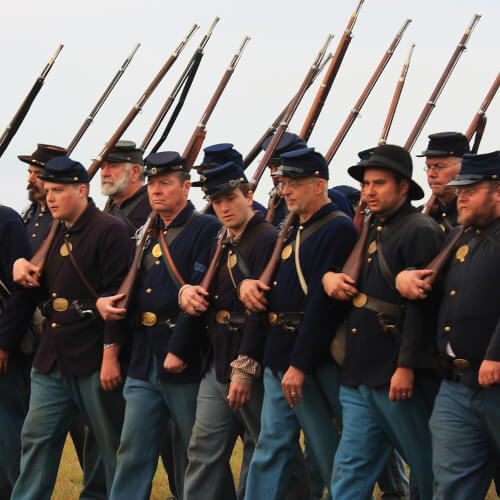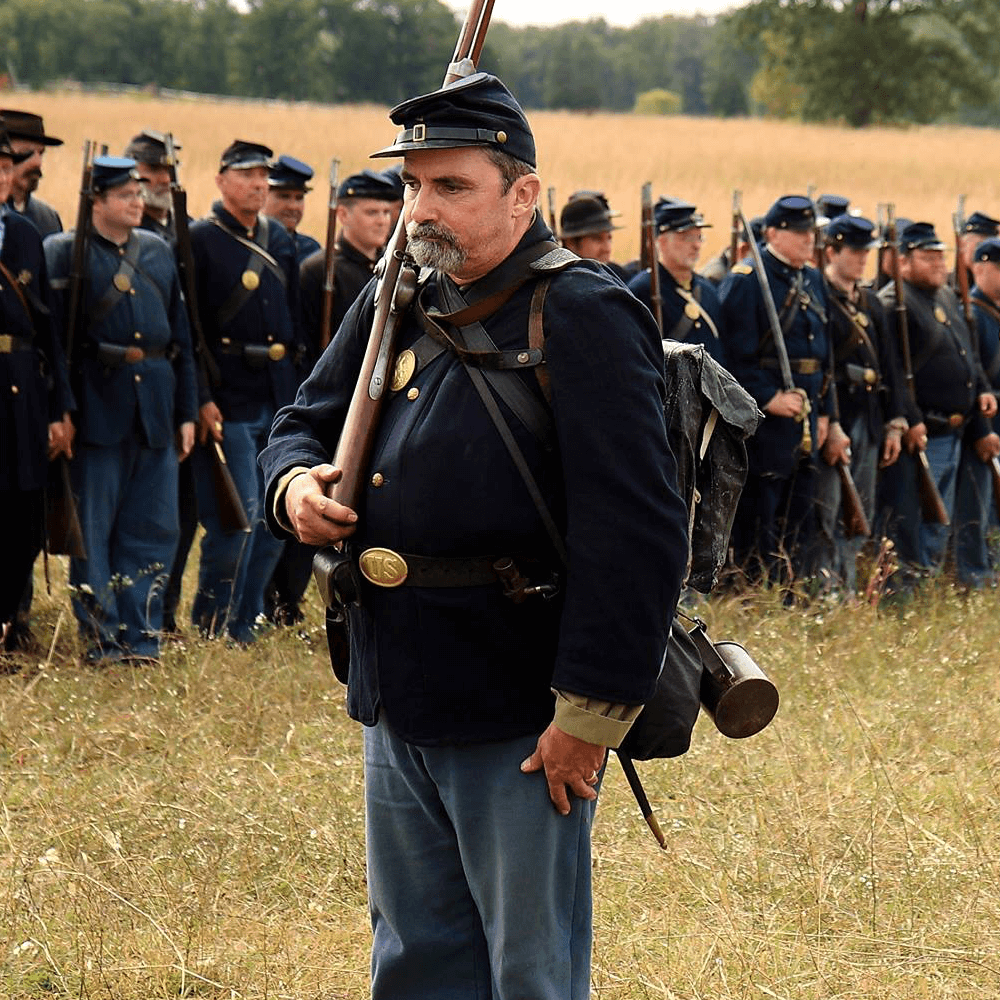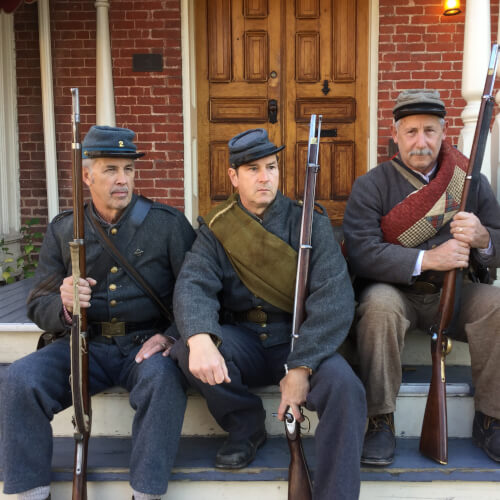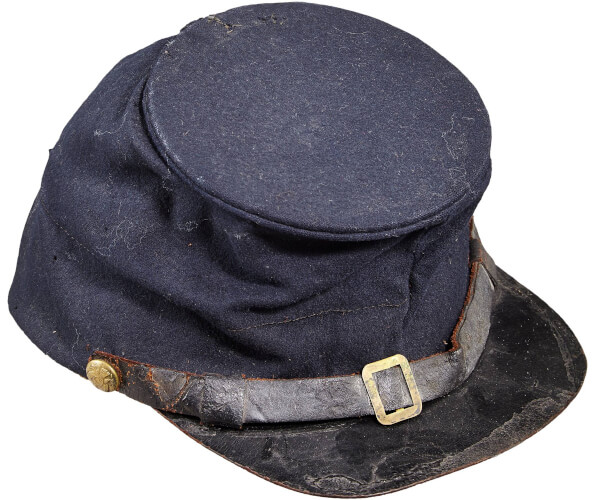Civil War Soldiers
Learning About The Common Soldier of the Civil WarUniforms of the Common Civil War Soldier
There were many different types of uniforms worn by Civil War soldiers both North and South. While officers were expected to buy their own uniforms, regular soldiers were issued with standard uniforms which were made according to strict military standards and designs. The Civil War uniforms of Union soldiers were predominantly blue while their Southern counterparts were gray or butternut. Buttons and other insignia were used for the identification of rank while colors designated the branch of service.
When people talk about the Civil War, they often talk about in terms of “the Blue and the Grey.” This is due in part to the fact that the Union army wore uniforms that were navy blue while the Confederates wore uniforms that were grey or brown. Throughout the Civil War, a soldier’s uniform became an essential part of their life. In addition to protection from the elements, the uniform helped distinguish North and South, it promoted a spirit of comradery and showed which branch of the service you were in infantry, cavalry or artillery.
Soldiers on both sides wore a wool uniform, a belt set that included a cartridge box, cap box, bayonet and scabbard, a haversack for rations, a canteen, and a blanket roll or knapsack which contained a wool blanket, a shelter half and perhaps a rubber blanket or poncho. Inside was a change of socks, writing paper, stamps and envelopes, ink and pen, razor, toothbrush, comb and other personal items. The amount of baggage each soldier carried differed from man to man.
Early War Uniforms
When the war broke out, neither side was ready to outfit their respective armies. In the beginning, unforms for the volunteers were locally obtained and were made from a variety of materials and styles. While the North tried to get all of the soldiers to wear dark or navy blue, many suppliers ran out and many Union soldiers were left wearing grey. This led to confusion on the battlefield until the North standardized on navy colored uniforms and the South used grey or brown.
Jackets
Union soldiers were issued several different types of uniform. All of them received a sack coat which was sometime was referred to as a fatigue blouse. The sack coat was made from a dark blue lightweight wool, had four brass buttons, an inside pocket and was usually lined with a piece of cotton or flannel. In addition to the sack coat, soldiers were issued a frock coat. The frock coat has nine buttons down the front, two on the back and two on each sleeve. While the sack coat came to a soldier’s waist, the frock coat was longer and came to a soldier’s mid-thigh. Meant to be a more formal coat for dress or parades, it had piping on the collar and cuff to identify the different divisions: red for artillery, light blue for infantry, yellow for cavalry. This coat had a padded quilting on the inside and it came with one inside pocket and two pockets in the tail.
Pants
Prior to the Civil War, officers and enlisted men were also issued dark blue trousers made wool. As the war broke out, enlisted men were issued light (sky) blue trousers to differentiate them from the officers. Non-commissioned officers (NCOs) also wore sky blue pants, but theirs would be adorned with a stripe of dark blue fabric running down the outside seam.
Hats
During the Civil War it was common for soldiers to have two kinds of headgear. An order issued by the U.S. War Department in 1858 called for enlisted men to receive each year one dress hat and a fatigue or forage cap. The Model 1858 forage cap was modeled after the shako used by the Regular Army in the 1850s. The forage cap was described as “shapeless as a feedbag” and became the most common form of cap worn by soldiers during the Civil War. Confederate regulations stated that soldiers were to wear a kepi however due to a shortage of materials, the Confederate kepi was closer to the Union cap and was gray or butternut made from wool.
In addition to the daily forage cap, the Union troops were also issued a formal hat that was made of black felt. One side of the hat was turned up and held in place with an eagle crest and had an ostrich feather running along the brim. The hat also came with embroidered insignia for officers and brass insignia for enlisted soldiers. The formal hat also was referred to as the Hardee hat, after LTC William Joseph Hardee, an officer of the 2nd Cavalry
Beginning in 1863, Union corps badges were designed for the different army corps and these were universally adopted for the top of the cap to help distinguish between corps. Some soldiers would also adorn their cap with brass letters of their regiment and company to further provide identification.
Accoutrements
Boots & Shoes
During the Civil War, soldiers wore a heavy, ankle-high boot or shoe often referred to as a brogan or bootee. The most common version of the brogan was the Model 1851 Jefferson. Brogans were made from leather with a square toe, four eyelets and leather laces. The soles were also leather but came with a metal heel plate and some versions had hob nails. Brogans were interchangeable with the left or right foot, supposedly allowing for even wear on the boots. Both artillery and cavalry were issued calf high leather boots. Some, in the cavalry, wore thigh high boots for added protection for the exposed leg on horseback.
Underwear
A soldier’s drawers were made from cotton flannel were ankle length with a double flannel waistband with two metal buttons in front and two pairs of eyelets behind to help hold the drawers up. Enlisted men were allotted three pairs of drawers and the first year of service and two pairs in each subsequent year. These cotton drawers act as the first layer against the skin wicking away moisture and keeping the wearer cool and dry while also providing an extra layer of warmth.
Soldiers were also issued shirts which were pullover style and made from muslin, cotton or flannel. The shirt had four buttons, a fold down collar and a longer tail.
Haversacks
Soldiers also carried a haversack which was a heavy cotton sack that provided them with a place to store and carry possessions, food and their personal items that they took from home. Haversacks were an essential and vital part of a soldier’s equipment and carried everything from hardtack to combs. Haversacks were either tarred or untarred heavy cotton
The tarred haversacks were made from a muslin type material and a black tar was applied to the outside in an attempt to make them water-resistant. While tarred haversacks were issued to the soldiers, untarred haversacks were made from a heavy muslin or cotton material.
Leather Gear
The cartridge box was a box to carry cartridges and was made from leather and came in various patterns depending on the caliber of the cartridge. The cartridge box was wither attached to a belt and worn on the hip or it was attached to a shoulder strap and worn on the soldier’s right hip with the strap going over his left shoulder. It was designed to hold 40 rounds of ammunition and came equipped with tins on the inside to hold the cartridges and protect the soldier. A brass “US” plate was attached to the flap to help weigh it down and keep it close. In addition to this box, a cap pouch was hung on the belt, and contained brass caps used to fire the weapons.
Learn More
Videos
Vocabulary
Bayonet: (pronounced bay-uh-net) A metal blade, like a long knife or short sword, that could be attached to the end of a musket or rifle-musket and used as a spear or pike in hand-to-hand combat.
Canteen: Round container used to carry water; made of wood or tin and carried over the shoulder by a strap.
Cartridge Box– This was a sturdy bag made of leather with a shoulder strap that would hold cartridges and bullets. The bag contains two tins, which each held up to twenty cartridge rounds.
Haversack: A small canvas bag with a shoulder strap that was used to carry a soldier’s food. The inside had a liner to separate food and it was often covered with a black tar on the outside to make it waterproof.
Kepi: Typical hat. worn by Civil War soldiers.
Knapsack – A type of backpack that soldiers wore and contained personal effects and came in either the double bag or the wood hard-side variety. Confederates sometimes resorted to a blanket roll to carry their personal belongings.




